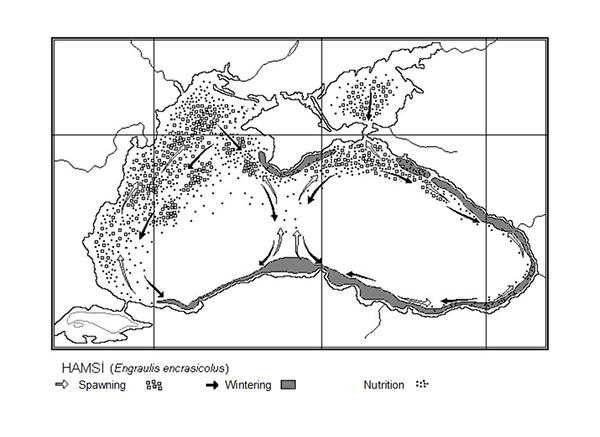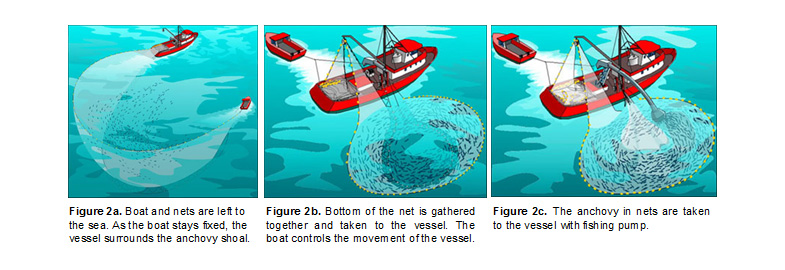ANCHOVY
Anchovy is a well-known fish all over the world. Anchovy is a big family with different kinds living in different waters from South Pacific Ocean, North Atlantic Ocean to Black Sea in the world.
Biggest schools of anchovy are living on west coasts of South America, in Peru. Peru has richest water for fisheries. The kind of anchovy living there is called Peruvian anchovy (Engraulis ringens). Peruvian anchovy is high in protein and omega3 fatty acids EPA and DHA. In Peru anchovy fishing is done in two different seasons in a year with a defined quota. Depending on the biomass measured by government authorized institute IMARPE (Instituto del Mar del Peru), they are allowed to catch up to 3-4 million tones anchovy yearly in Peru. Sometimes anchovies are interrupted by El Nino which brings warm water current to ocean and influences the life of anchovy. In Peru they produce high quality fish oil and fish meal from Peruvian anchovy and also they are doing canning of salted anchovy and export to all over the world.
Anchovy is also living in Black Sea.
Black Sea is most distant sea from the Atlantic Ocean. It combines Azov Sea through Kerch, through Bosporus with Marmara Sea and through Dardanelles to Aegean and Mediterranean Sea. The coastal countries of Black Sea are Turkey, Georgia, the Russian Federation, Ukraine, Bulgaria and Romania. These countries are fishing anchovy in Black Sea. The government experts from these countries are gathering together regularly every year. They discuss and having rules in order to protect ecosystem in Black sea by avoiding pollution and keeping sustainable fishing in Black Sea.
There are two different anchovy populations living in Black Sea: Black Sea anchovy (Latin: Engraulis encrasicolus ponticus) and Azov anchovy (Latin: Engraulis encrasicolus maeticus).
Anchovy are a small and fast growing species. In Turkey Anchovy is called “Hamsi” (which is derived from “Hamsin”, an Arabic term for the winter period) and fishing season is from November to March.
Anchovy holds an important place in fishing in Turkey. Anchovy is the most caught fish in Turkey which three sides are surrounded by sea. Anchovy fishing has a positive influence on economic growth north coast of Turkey. Anchovy is a tradition in Black Sea region. Anchovy has an impact on life of people in Black Sea; from contribution to economy, 61 different meals, jokes and etc. Anchovy is a culture especially in Trabzon where most of the biggest fishermen and fishing fleet come from.
REPRODUCTION AND MIGRATION OF ANCHOVY IN BLACK SEA
According to Ivanov ve Beverton (1985), Black Sea Anchovy migrates to the north coasts of Black Sea for spawning and feeding. As the weather gets colder, anchovy migrates to Turkish coasts. According to the speed of changes at water temperature decrease or increase, the migration of anchovy can be through the coast or directly passing to the Turkish coast. Similar to Black Sea anchovy, Azov anchovy feeds in Azov Sea and then moves to the Black Sea passing through Strait of Kerch. The Marmara anchovy move to Black Sea for spawning and feeding and in winter they return back to Marmara Sea.

Changes in the spawning areas of anchovy can be seen in Figure 1.
Anchovy feeds on zooplankton. Anchovy lives approximately 3-4 years. 3 years old anchovy is about 12-13cm long. Anchovy reproduction can take place at age of 1 year old and it is estimated that anchovy is approx. 9,5cm long.
Anchovy are pelagic fish and forms big schools at defined temperatures. Anchovy are caught using purse-seine nets in mid-water. With the help of a boat the shoal of anchovy is surrounded with nets and anchovy are taken to the vessel.

The research for determining biomass and migration of anchovy at Black Sea has been started in 2011 by “METU Institute of Marine Sciences” and “Republic of Turkey ministry of food, agriculture and livestock SÜMEA”. The biomass measurements still continues. Two stock assessment methods (XSA and ASPIC) were applied to Black Sea anchovy and measurements are still going on. For more information:
Central Fisheries Research Institute which is researching anchovy and other species in Black Sea
METU Institute of Marine Sciences
REFERENCES
1. Bingel, F., Gücü A.C., 2010. Karadeniz Hamsisi ve Stok (Tespiti) çalışmaları; 1. Ulusal hamsi Çalıştayı: Sürdürülebilir balıkçılık; 2010
2. Bilgin, S., Samsun, N., Samsun, O. ve Kalaycı, F., 2006. Orta Karadeniz’de 2004-2005 av sezonunda avlanan hamsi’nin Engraulis encrasicolus L. 1758, boy-frekans analiz metodu ile populasyon parametrelerinin tahmini. EÜ, Su Ürünleri Fakültesi Dergisi, ISSN 1300-1590, Cilt: 23, Sayı: 1-3 Ek sayı, 359-364.
3. Genç Y., 2007. Son 20 yılda Türkiye’deki hamsi avcılığı, Yunus Araştırma Bülteni, Yıl: 7, sayı 2, Su Ürünleri Merkez Araştırma Enstitüsü, Trabzon.
4. Evliya Çelebi 1672: Evliya Çelebi Seyahatnamesi. Sadeleştiren T. Temel-Kıran, N. Ateş. Cilt I-II.Üçdal Neşriyat, İstanbul, 1986.
5. Ivanov, L., Beverton, R. J. H., 1985: The fish resources of the Mediterranean. Part two: Black Sea.Etud. Rev. CGPM/Stud. Rev. GFCM
6. URL: http://www.yelkenli.com/bilgi/hamsi.pdf
7. URL: http://www.balikcilar.net/girgir-aglariyla-avcilik-2803.html
8. JRC Scientific and Policy reports; “Black Sea assessments (STEFC-14-14)” https://stecf.jrc.ec.europa.eu/documents/43805/853348/2014-11_STECF+14-14+-+Black+Sea+assessments_JRC92536.pdf
